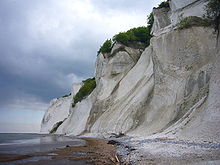Møns Klint
Coordinates: 54 ° 57 ′ 51 ″ N , 12 ° 33 ′ 8 ″ E
Møns Klint is the highest cliff in Denmark .
Geographical-geological description
The chalk cliff is in the east of the Baltic island of Møn . The limestone wall is 6 km long and up to 128 m high. The highest point in the hinterland is 143 m high. The chalk that forms the cliff was created around 70 million years ago ( Upper Cretaceous Period ) on the bottom of a sea. The chalk consists mainly of the remains of the calcareous shells of microscopic algae ( coccoliths ) that populated the primeval sea. The numerous black flint bands that stand out in the profile of the cliff are striking . Among the numerous fossils that occurred in the Upper Cretaceous period and that can be found at the foot of the cliff but also on the surrounding beaches, some are preserved in flint (e.g. the stone cores of sea urchins that are often found ).
Surroundings
The land above the cliff is a unique collection of different biotopes . The combination of calcareous soil, the dry local climate and the limited agriculture , which mainly consists of pasture farming , enable a landscape rich in species , as it probably existed before the industrialization of agriculture.
Chalk falls
The cliff is one of the main attractions on the island of Møn. In several places stairs lead down to the water. The 497-step main staircase that leads down from the GeoCenter to the cliffs is a small tourist attraction in its own right. The descent and the stay on the beach is not without risk, however, as larger pieces break out of the steep face again and again.
In the 20th century alone, five major fractions were counted:
- In 1905 a third of the Liselund Castle Park fell into the sea.
- In 1914 large parts of the northern “Queen's Chair” (Dronningestolen) were washed away.
- In 1952, a 500-meter-long peninsula was formed when dozens of tons of chalk, clay and pebbles fell off Vitmunds Nakke and Puggards Klint.
- In 1980 a large part of the northern “summer peak” ( summer spiret ) disappeared into the sea, in 1988 the rest.
- In January 2007 there was a massive fall of chalk, which caused 500,000 tons of chalk to fall around the “Großer Redner” ( Store Taler ). This was the worst crash in 50 years.
Møns Klint in art
Møns Klint was particularly popular with Danish landscape painters in the Golden Age of Denmark (Danish: den danske guldalder ), an epoch of high cultural prosperity . Many artists - including some several times - painted the chalk cliff from different perspectives, at different times of the day and under very different lighting conditions.
Udsigt af Møns Klint og Sommerspiret (1809), Christoffer Wilhelm Eckersberg (1783-1853)
Parti fra Møns Klint med Sommerspiret (1830), Frederik Hansen Sødring (1809–1862)
Sommerspiret (1842), Louis Gurlitt (1812-1897)
Parti fra Møns Klint (1852), Peter Christian Skovgaard (1817–1875)
Sommerdag vid Møns Klint (1857), Carsten Henrichsen (1824–1897)
Sommerdag på Møns Klint (1877), Carl Frederic Aagaard (1833–1895)
literature
- G. Larsen: Fyn og Øerne. (published in the series Geologisk set ) Geografforlaget, Brenderup (DK) 2002, 144 p., numerous. Fig and maps.
Web links
- GeoCenter Møns Klint (German, Danish)
- Photographs private website
- [1] Information about Møns Klint (including a map of the area)
Individual evidence
- ↑ Map of the area naturstyrelsen.dk, accessed on February 4, 2019









